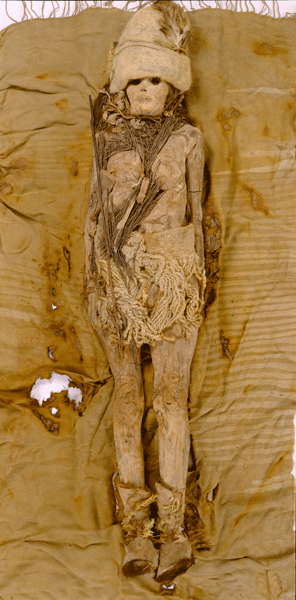Il clima arido del deserto è stato un vero colpo di fortuna: ha permesso di rinvenire resti di formaggio dell'Età del Bronzo in ottimo stato di conservazione e di ricavarne la ricetta.
Non era fatto con il caglio (o presame), bensì con latte, lievito e batteri (quindi lasciato fermentare). Praticamente, si ottiene unformaggio che non si guasta né irrancidisce rapidamente insieme ad un sottoprodotto liquido - il 'kefir' - che, come il formaggio, non contiene lattosio ed è quindi adatto ad una popolazione di intolleranti qual'era quella di allora.
Si è trattato di una serie di coincidenze. Lo studio è stato fatto perché gli archeologi cinesi hanno pensato di mandare campioni del 'donario' rituale di una mummia (la bellezza di Xiaohe: doveva essere - anche se oggi non sembra - una donna molto bella) splendidamente conservata all'Istituto Max Planck, perché fossero analizzati con metodi moderni. E' stato quindi impostato uno studio d'avanguardia sulle proteine di un materiale che non era ancora stato sequenziato (e che aprirà la strada a nuove ricerche proteomiche per uso archeometrico).
Early Bronze Age
cheese recipe
reconstructed
Normally, Andrej Shevchenko and his team at the Max Planck Institute of Molecular Cell Biology and Genetics in Dresden analyse proteins and fats in the cells of fruit flies or roundworms.
In this case, however, the scientists dealt with some very unusual samples: misshapen fragments that turned out to be the remnants of cheese from the Early Bronze Age, making them the earliest known cheese yet to be discovered.
The cheese fragments represent funerary goods that were found around the neck and on the chest of a 4,000-year-old mummified body uncovered at the Xiaohe burial site in Xinjiang, western China.
Their analysis enabled the researchers to recreate the recipe for the cheese: like kefir, it was made of milk with the addition of a mixture of bacteria and yeast, and subsequently fermented.
Small cheese clumps are scattered around the neck of the female mummy as a burial offering.
At the time, people needed no natural rennet from the stomach of animals for the production of cheese made of milk, yeast, and bacteria. It was therefore not necessary to slaughter any young animals [Credit: Y. Liu, Y. Yang]
The 4,000-year-old Xiaohe cheese represents the oldest remains of a milk product ever found. The extremely arid climate in the Taklamakan Desert, where the Xiaohe burial ground is located, meant that the cheese residues were exceptionally well preserved – a real stroke of luck for the Dresden-based researchers. The cheese found on the mummies was produced with bacteria and yeast, not with rennet: “This meant that no young animals had to be slaughtered – a major advantage of this production method,” explains Shevchenko. According to the scientist’s interpretation, this may have been instrumental in the spread of cattle herding on a large scale throughout Asia. “The method of making this kefir cheese is simple; it doesn’t spoil or turn rancid quickly. So the cheese is extremely well suited to mass production.” As a precursor to the cheese, the process of fermentation with kefir grains also produces the probiotic milk drink known as kefir. Both products contain hardly any lactose – ideal for the population groups living in Asia, most of which are lactose intolerant.

The "Beauty of Xiaohe": the approx. 4,000 year-old mummy of a woman from Western China [Credit: Y. Liu, Y. Yang]
Andrej Shevchenko’s wife Anna heads the Mass Spectrometry Department at the same Institute. The two researchers have only recently completed another archaeology project and published their findings. In her desk drawer, Anna Shevchenko still has a few plastic tubes filled with light-brown crumbs – 2,500-year-old funerary goods found during excavations at the ancient Chinese burial ground of Subeixi. “We analysed protein residues from an earthenware dish and were able to reconstruct a prehistoric recipe for leavened bread,” she relates. “We never actually had archaeology on our radar screen. We just kind of stumbled across it thanks to an e-mail enquiry sent by Chinese archaeologist Yimin Yang,” says Shevchenko. Yang had come up with the idea of having his finds analysed with ultramodern quantitative proteomics methods, whereupon he sent the scientists in Dresden the first cheese fragments. Before they could proceed, they had to develop methods of identifying proteins from organisms whose DNA had not yet been sequenced. The projects are therefore truly pioneering and demonstrate most notably that quantitative proteomics is not only suitable for use in biomedical research, but could also represent a promising method for archaeology: “The analytical methods used in archaeology to date always looked at DNA or fats – yet these are often totally useless, especially when it comes to very old organic samples. Proteins have been ignored so far because it was always believed that they would be completely decomposed, that they’re difficult to handle and that the results might be contaminated with proteins from the ambient environment. So our method opens up brand new possibilities for the analysis of organic residues on archaeological finds,” says Anna Shevchenko. Unlike fats, proteins carry a great deal of information inside them in molecular form: for instance, the arrangement of amino acids, the building blocks of the proteins, can also contain signs of the processes used, like fermentation. As such, proteomics could develop into an interesting and suitable method in archaeometry.
The discovery has been published in the Journal of Archaeological Science.
Source: Max Planck Society
[March 11, 2014]
Read more at: http://archaeologynewsnetwork.blogspot.it/2014/03/early-bronze-age-cheese-recipe.html?utm_source=feedburner&utm_medium=feed&utm_campaign=Feed:+TheArchaeologyNewsNetwork+(The+Archaeology+News+Network)#.UyKG6j95OSo
Follow us: @ArchaeoNewsNet on Twitter | groups/thearchaeologynewsnetwork/ on Facebook
